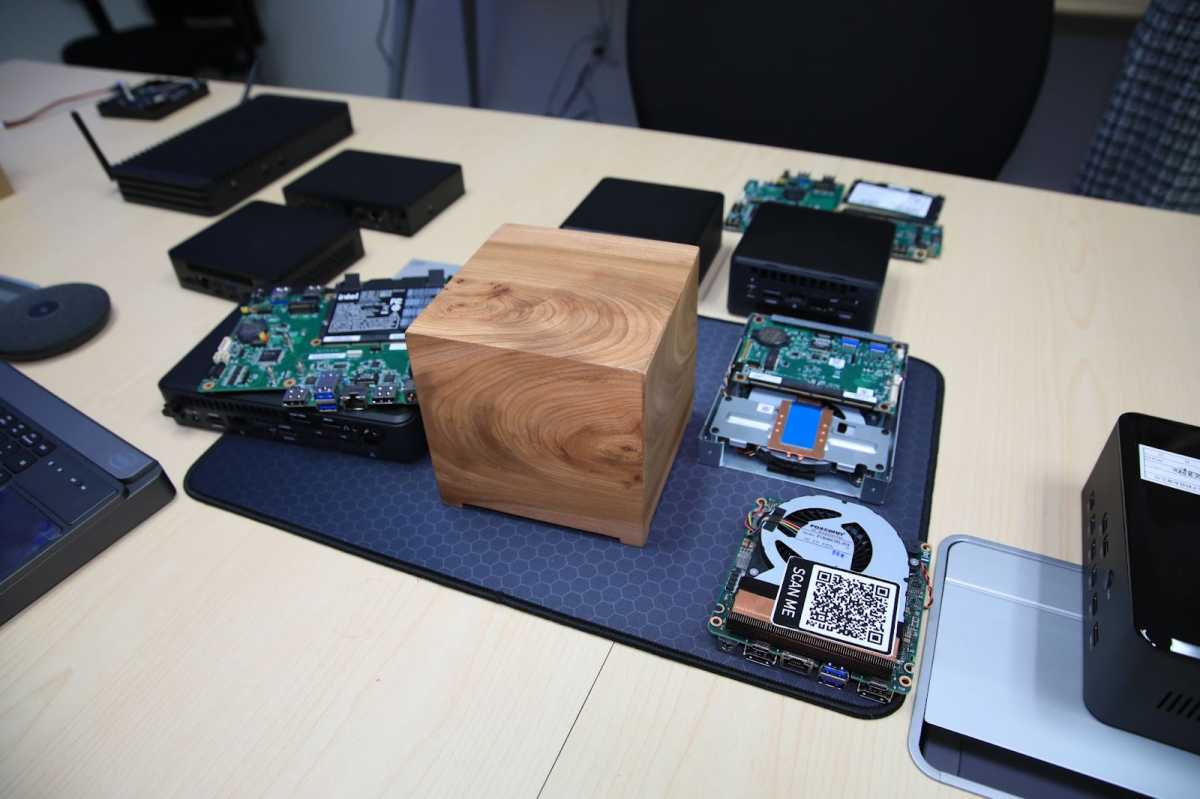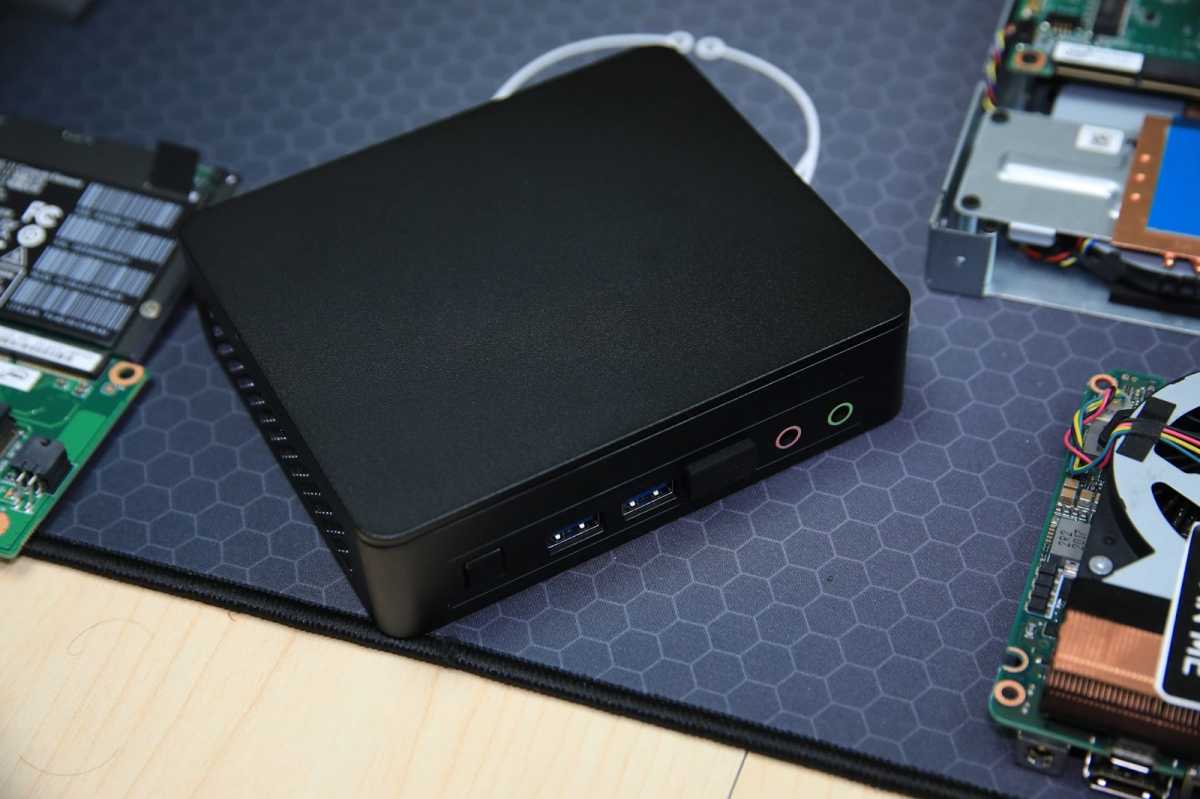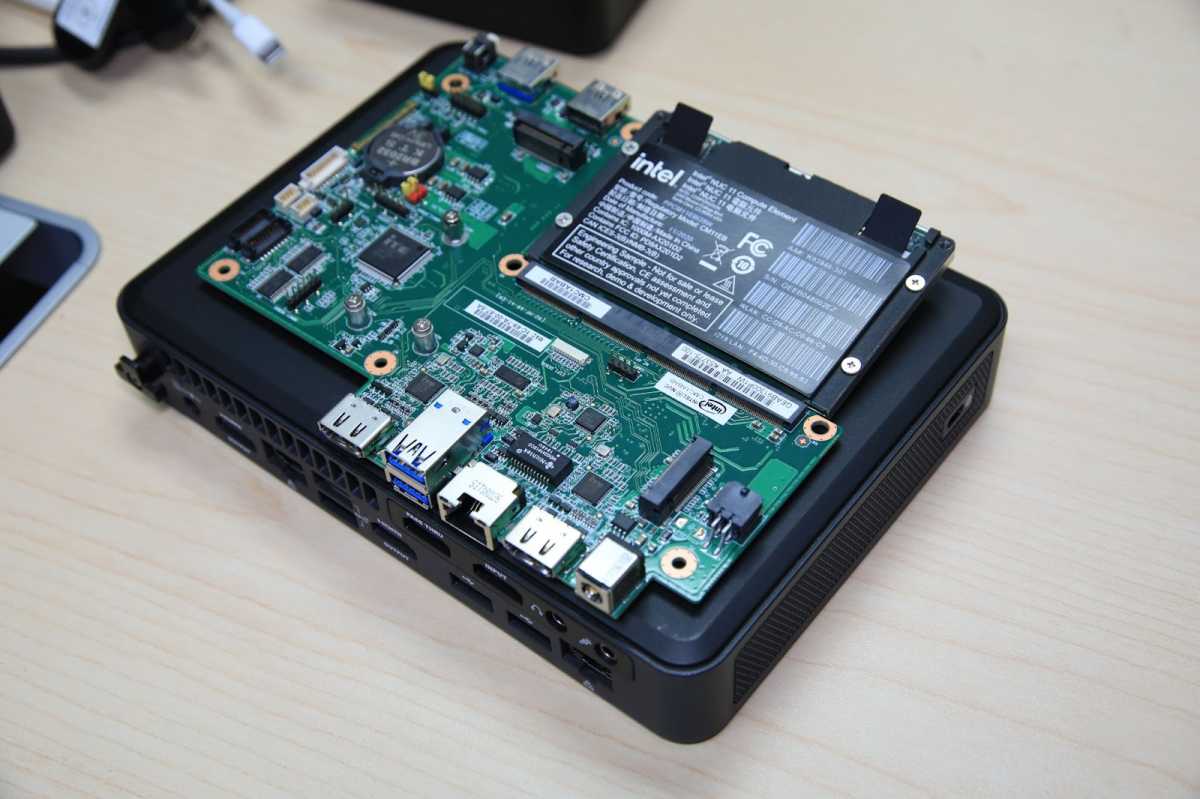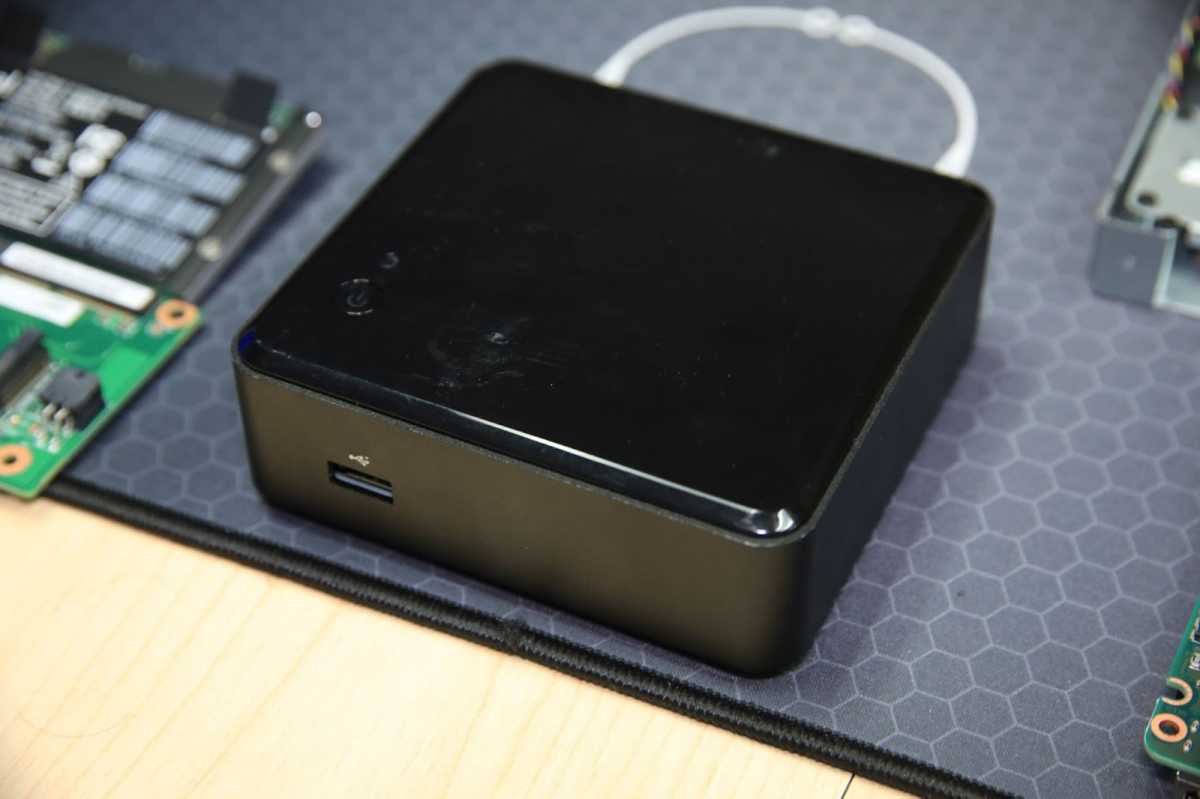8 weird and awesome Intel NUCs you've never heard of

 Image: Matt Smith/IDG
Image: Matt Smith/IDGIntel’s classic “4×4” NUC, which measures about four inches wide and deep, is the most iconic NUC design – but it’s far from the only machine the group sells.
The NUC group’s efforts now span across 600 total variations that cover nearly every use you could possibly fathom. You’ll find NUCs in gaming PCs and train cars, behind kiosks and in developer workstations.
Many of these NUCs are not the design you recognize but specialty machines built for a specific purpose. Some aren’t even sold through retail channels—though you may wish they were. We ran into eight particularly interesting models during our recent visit to Intel’s NUC labs, where we discovered the secrets behind the project that revolutionized tiny computing. Feast your eyes on these!
ShinZhen Kihitech keyboard PC

Matt Smith/IDG
Matt Smith/IDG
Matt Smith/IDG
Built around an Intel Compute Element, this keyboard is a fully functional Windows PC with all the features, ports, and connectivity you’d expect—as well as some you might not, like a VGA port for legacy monitors. The Compute Element can be swapped out, too, unlocking future processor upgrades.
But wait—there’s more! The keyboard on this NUC-powered machine is actually a wireless keyboard with a built-in battery, meaning it can be removed from the baseboard and used independently. A touchpad is also included, as you can see, so a wireless mouse isn’t required.
This model even lists 4G cellular data connectivity. While this PC lacks a battery for truly portable use, the cellular data option would be useful in locations where wired Internet service is less common than wireless.
It’s an alluring option for enthusiasts who want a new PC with that old-school, early-80s computing feel, or for those who want an all-in-one home theater computer. Unfortunately, the keyboard PC is out of reach for most readers, as it’s only sold in the Chinese market.
Bleujour Wood Kubb

Matt Smith/IDG
Matt Smith/IDG
Matt Smith/IDG
Leave it to the French to turn the NUC’s stocky, functional design into a friendly, approachable cube.
The Wood Kubb is part of Bleujour’s Kubb line, which includes not only the Wood Kubb but also a more colorful (and affordable) mainstream line, plus a fanless Kubb for those who absolutely despise noise.
An entry-level Kubb has a Core i3-1115G4 processor, 8GB of RAM, and 512GB of solid state storage. You can upgrade the Kubb to a Core i7, 64GB of RAM, and up to two 2TB solid state drives.
Starting at 645 Euros, or 755 for the wood enclosure, Kubb’s design statement doesn’t come cheap (though it’s worth noting that PC prices generally skew higher in Europe). That’s expensive, but hey—it’s not like you have a dozen other wood PCs to choose from.
Dawson Canyon with custom LTE lid

Matt Smith/IDG
Matt Smith/IDG
Matt Smith/IDG
Dawson Canyon NUCs arrived in 2018 with Intel’s 7th-gen and, later, 8th-gen Core processors. The top model, which had an Core i7-8650U processor, was the most performant version of the classic 4×4 yet. But that’s not what makes this NUC notable.
That honor goes to the antennas.
Massive antennas aren’t a standard feature and, in this case, they serve a unique and useful purpose: 4G LTE connectivity. This particular NUC has been modified to receive a strong mobile data signal, allowing Internet access from anywhere mobile data is available.
This showcases an underappreciated feature of the original 4×4 design: the lid. What looks like a simple plastic cap is actually a portal to possibility. Removing the lid provides access to a M.2 PCIe storage slot and internal USB headers. Plus, it uses a simple clip-on mechanism that makes custom lids easy to swap out.
Atlas Canyon

Matt Smith/IDG
Matt Smith/IDG
Matt Smith/IDG
The Atlas Canyon NUC might not look like a new, cutting-edge model, but in many ways it is. A new addition to the NUC line sold as an “essential NUC,” Atlas Canyon uses entry-level Intel processors like the Pentium Silver N6005 and Celeron N5105. This model is slightly wider than the classic 4×4 design but significantly thinner, at just 1.5 inches thick.
These processors won’t set benchmark records, of course, but they provide a very low price point. The Atlas Canyon NUCs are “fully configured” starting at $299 (though this doesn’t include a Windows license). They’re meant primarily for kiosks and digital signage, which might sound boring, but it represents a big part of NUC’s success.
Tinkerers should keep an eye on the NUC 11 Essential board. Slated to sell for only $199 when it arrives later this year, it will have quad-core Celeron N5105 processor with support for up to 32GB of RAM and NVMe storage, plus six USB ports, HDMI, and DisplayPort. It might be a great option for low-cost project PCs.
Bleujour RIDG

Matt Smith/IDG
Matt Smith/IDG
Matt Smith/IDG
Bleujour is at it again, though this time in a widely different design and more capable design. What you’re looking at is the RIDG, an upcoming workstation PC teased at CES 2022.
Yep, that’s right—this is a workstation PC. Despite its rather compact design and wild shape, the RIDG is built around an Intel NUC Extreme Compute Element and provides room for a single-slot PCIe x16 graphics card.
To be specific, this model offers up to Intel Xeon vPro processors and Nvidia Quadro RTX A4000 graphics. The RTX A4000 is a very capable piece of hardware despite its single-slot design, with performance close to that of an RTX 3070.
Not yet available for purchase on Bleujour’s website, the RIDG is expected to arrive sometime this year. A press release published through Techtimes shows a steep entry-level price of $3,995 Euros – expensive but unsurprising given its size, performance, and all-metal chassis.
Fort Beach

Matt Smith/IDG
Matt Smith/IDG
Matt Smith/IDG
The Fort Beach NUC may seem a puzzle from the outside. Much wider and broader than the classic 4×4 NUC, Fort Beach seems to gain little from its added bulk. It has a similar number of ports and provides access to a similar range of Intel Pentium, Celeron, and Core processors.
It’s what inside the counts. Look closely at the photo above and you’ll discover Fort Beach’s secret: This NUC doesn’t have a processor soldered to the board. It instead uses the Intel Compute Element, which connects over a custom PCIe slot.
This design offers the potential of future upgradability with better, faster Compute Elements. This could be handy, as the NUC’s board otherwise provides a selection of connectivity that shouldn’t need replacement anytime soon. There’s also a model with optional video and audio capture card that slots into the machine’s rear.
Ice Canyon

Matt Smith/IDG
Matt Smith/IDG
Matt Smith/IDG
Alright, the Ice Canyon NUC isn’t weird—but it is important. Launched in 2013, the Ice Canyon NUC was the successor to Intel’s debut NUC and the first to have an Intel Core processor. This gave a big boost to the NUC’s performance and made it a genuinely useful device for mundane, day-to-day Windows computing.
You’ll notice the Ice Canyon NUC looks a bit different from other, more recent models. This original 4×4 design, which has both a compact footprint and thin profile, remains the smallest complete NUC system available. Most NUCs are now larger, though this form factor is still available today with the Tiger Canyon and Provo Canyon models.
Despite its age, the Ice Canyon NUC did support mSATA PCIe SSDs, making it one of the first desktop PCs to support PCIe solid state storage. Ice Canyon also added an Ethernet LAN port, a feature missing from the prior Box Canyon NUC.
NUC Compute Element Extreme enclosures

Matt Smith/IDG
Matt Smith/IDG
Matt Smith/IDG
Though not a specific model, as such, the arrival of custom enclosures built around Intel’s NUC Compute Element Extreme are an option for enthusiasts who want a high-end PC in a slim form factor.
Intel’s own NUC Extreme Kit is the most widely available, but a variety of alternatives have appeared. These include complete systems like Razer’s Tomahawk, Bleujour’s Move Ultimate, and AVA Direct’s Compute Element. Enclosures, plus enclosures such as the MasterCaseNC100, Silverstone Vital 4, and Akasa Venom QX.
All of these share a common component: the baseboard, which includes a pair of PCIe slots supporting one Compute Element Extreme and one PCIe x16 video card. Intel has plans to improve this baseboard in the near future with better integration of component power supplies. This should remove some of the fuss from current systems based on the Compute Element Extreme which, though compact, can trouble owners with tight spaces that make power connectors difficult to attach.
Author: Matthew S. Smith
Matthew S. Smith is a freelance technology journalist with 15 years of experience reviewing consumer electronics. In addition to PCWorld, his work can be found on Wired, Ars Technica, Digital Trends, Reviewed, IGN, and Lifewire. Matthew also covers AI and the metaverse for IEEE Spectrum and runs Computer Gaming Yesterday, a YouTube channel devoted to PC gaming history.
Recent stories by Matthew S. Smith:
Are ultrawide monitors worth it?Deep inside Intel’s NUC: We visited Intel’s lab to learn the secrets of tiny computing







